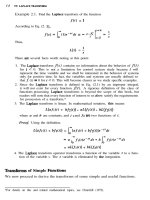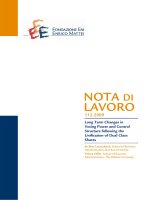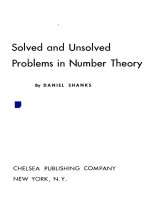Unsolved Problems in Mathematical Systems and Control Theory pptx
Bạn đang xem bản rút gọn của tài liệu. Xem và tải ngay bản đầy đủ của tài liệu tại đây (1.37 MB, 350 trang )
Unsolved Problems in
Mathematical Systems and
Control Theory
Edited by
Vincent D. Blondel
Alexandre Megretski
PRINCETON UNIVERSITY PRESS
PRINCETON AND OXFORD
iv
Copyright
c
2004 by Princeton University Press
Published by Princeton University Press, 41 William Street, Princeton, New
Jersey 08540, USA
In the United Kingdom: Princeton University Press, 3 Market Place, Wood-
stock, Oxfordshire OX20 1SY, UK
All rights reserved
Library of Congress Cataloging-in-Publication Data
Unsolved problems in mathematical systems and control theory
Edited by Vincent D. Blondel, Alexandre Megretski. p. cm.
Includes bibliographical references.
ISBN 0-691-11748-9 (cl : alk. paper)
1. System analysis. 2. Control theory. I. Blondel, Vincent. II. Megretski,
Alexandre.
QA402.U535 2004 2003064802
003—dc22
The publisher would like to acknowledge the editors of this volume for pro-
viding the camera-ready copy from which this book was printed.
Printed in the United States of America
10 9 8 7 6 5 4 3 2 1
I have yet to see any problem, however complicated, which, when
you looked at it in the right way, did not become still more compli-
cated.
Poul Anderson
Contents
Preface xiii
Asso ciate Editors xv
Website xvii
PART 1. LINEAR SYSTEMS 1
Problem 1.1. Stability and composition of transfer functions
Guillermo Fern´andez-Anaya, Juan Carlos Mart´ınez-Garc´ıa 3
Problem 1.2. The realization problem for Herglotz-Nevanlinna functions
Seppo Hassi, Henk de Snoo, Eduard Tsekanovski˘ı 8
Problem 1.3. Does any analytic contractive operator function on the polydisk
have a dissipative scattering nD realization?
Dmitry S. Kalyuzhniy-Verbovetzky 14
Problem 1.4. Partial disturbance decoupling with stability
Juan Carlos Mart´ınez-Garc´ıa, Michel M alabre, Vladimir Kuˇcera 18
Problem 1.5. Is Monopoli’s model reference adaptive controller correct?
A. S. Morse 22
Problem 1.6. Model reduction of delay systems
Jonathan R. Partington 29
Problem 1.7. Schur extremal problems
Lev Sakhnovich 33
Problem 1.8. The elusive iff test for time-controllability of behaviors
Amol J. Sasane 36
viii CONTENTS
Problem 1.9. A Farkas lemma for behavioral inequalities
A.A. (Tonny) ten Dam, J.W. (Hans) Nieuwenhuis 40
Problem 1.10. Regular feedback implementability of linear differential behaviors
H. L. Trentelman 44
Problem 1.11. Riccati stability
Erik I. Verriest 49
Problem 1.12. State and first order representations
Jan C. Willems 54
Problem 1.13. Projection of state space realizations
Antoine Vandendorpe, Paul Van Dooren 58
PART 2. STOCHASTIC SYSTEMS 65
Problem 2.1. On error of estimation and minimum of cost for wide band noise
driven systems
Agamirza E. Bashirov 67
Problem 2.2. On the stability of random matrices
Giuseppe C. Calafiore, Fabrizio Dabbene 71
Problem 2.3. Asp ects of Fisher geometry for stochastic linear systems
Bernard Hanzon, Ralf Peeters 76
Problem 2.4. On the convergence of normal forms for analytic control systems
Wei Kang, Arthur J. Krener 82
PART 3. NONLINEAR SYSTEMS 87
Problem 3.1. Minimum time control of the Kepler equation
Jean-Baptiste Caillau, Joseph Gergaud, Joseph Noailles 89
Problem 3.2. Linearization of linearly controllable systems
R. Devanathan 93
Problem 3.3. Bases for Lie algebras and a continuous CBH formula
Matthias Kawski 97
CONTENTS ix
Problem 3.4. An extended gradient conjecture
Luis Carlos Martins Jr., Geraldo Nunes Silva 103
Problem 3.5. Optimal transaction costs from a Stackelberg perspective
Geert Jan Olsder 107
Problem 3.6. Does cheap control solve a singular nonlinear quadratic problem?
Yuri V. Orlov 111
Problem 3.7. Delta-Sigma modulator synthesis
Anders Rantzer 114
Problem 3.8. Determining of various asymptotics of solutions of nonlinear time-
optimal problems via right ideals in the moment algebra
G. M. Sklyar, S. Yu. Ignatovich 117
Problem 3.9. Dynamics of principal and minor component flows
U. Helmke, S. Yoshizawa, R. Evans, J.H. Manton, and I.M.Y. Mareels 122
PART 4. DISCRETE EVENT, HYBRID SYSTEMS 129
Problem 4.1. L
2
-induced gains of switched linear systems
Jo˜ao P. Hespanha 131
Problem 4.2. The state partitioning pr oblem of quantized systems
Jan Lunze 134
Problem 4.3. Feedback control in flowshops
S.P. Sethi and Q. Zhang 140
Problem 4.4. Decentralized control with communication between controllers
Jan H. van Schuppen 144
PART 5. DISTRIBUTED PARAMETER SYSTEMS 151
Problem 5.1. Infinite dimensional backstepping for nonlinear parabolic PDEs
Andras Balogh, Miroslav Krstic 153
Problem 5.2. The dynamical Lame system with boundary control: on the struc-
ture of reachable sets
M.I. Belishev 160
x CONTENTS
Problem 5.3. Null-controllability of the heat equation in unbounded domains
Sorin Micu, Enrique Zuazua 163
Problem 5.4. Is the conservative wave equation regular?
George Weiss 169
Problem 5.5. Exact controllability of the semilinear wave equation
Xu Zhang, Enrique Zuazua 173
Problem 5.6. Some control problems in electromagnetics and fluid dynamics
Lorella Fatone, Maria Cristina Recchioni, Francesco Zirilli 179
PART 6. STABILITY, STABILIZATION 187
Problem 6.1. Cop osit ive Lyapunov functions
M. K. C¸ amlıbel, J. M. Schumacher 189
Problem 6.2. The strong stabilization problem for linear time-varying systems
Avraham Feintuch 194
Problem 6.3. Robustness of transient behavior
Diederich Hinrichsen, Elmar Plischke, Fabian Wirth 197
Problem 6.4. Lie algebras and stability of switched nonlinear systems
Daniel Liberzon 203
Problem 6.5. Robust stability test for interval fractional order linear systems
Ivo Petr´aˇs, YangQuan Chen, Blas M. Vinagre 208
Problem 6.6. Delay-independent and delay-dependent Aizerman pr oblem
Vladimir R˘asvan 212
Problem 6.7. Open problems in control of linear discrete multidimensional sys-
tems
Li Xu, Zhiping Lin, Jiang-Qian Ying, Osami Saito, Yoshihisa Anazawa 221
Problem 6.8. An open problem in adaptative nonlinear control theory
Leonid S. Zhiteckij 229
Problem 6.9. Generalized Lyapunov theory and its omega-transformable regions
Sheng-Guo Wang 233
CONTENTS xi
Problem 6.10. Smooth Lyapunov characterization of measurement to error sta-
bility
Brian P. Ingalls, Eduardo D. Sontag 239
PART 7. CONTROLLABILITY, OBSERVABILITY 245
Problem 7.1. Time for local controllabi lity of a 1-D tank containing a fluid
modeled by the shallow water equations
Jean-Michel Coron 247
Problem 7.2. A Hautus test for infinite-dimensional systems
Birgit Jacob, Hans Zwart 251
Problem 7.3. Three problems in the field of observability
Philippe Jouan 256
Problem 7.4. Control of the KdV equation
Lionel Rosier 260
PART 8. ROBUSTNESS, ROBUST CONTROL 265
Problem 8.1. H
∞
-norm approximation
A.C. Antoulas, A. Astolfi 267
Problem 8.2. Noniterative computation of optimal value in H
∞
control
Ben M. Chen 271
Problem 8.3. Determining the least upper bound on the achievable delay margin
Daniel E. Davison, Daniel E. Miller 276
Problem 8.4. Stable controller coefficient perturbation in floating point imple-
mentation
Jun Wu, Sheng Chen 280
PART 9. IDENTIFICATION, SIGNAL PROCESSING 285
Problem 9.1. A conjecture on Lyapunov equations and principal angles in sub-
space identification
Katrien De Cock, Bart De Moor 287
xii CONTENTS
Problem 9.2. Stability of a nonlinear adaptive system for filtering and parameter
estimation
Masoud Karimi-Ghartemani, Alireza K. Ziarani 293
PART 10. ALGORITHMS, COMPUTATION 297
Problem 10.1. Root-clustering for multivariate polynomials and robust stability
analysis
Pierre-Alexandre Bliman 299
Problem 10.2. When is a pair of matrices stable?
Vincent D. Blondel, Jacques Theys, John N. Tsitsiklis 304
Problem 10.3. Freeness of multiplicative matrix semigroups
Vincent D. Blondel, Julien Cassaigne, Juhani Karhum¨aki 309
Problem 10.4. Vector-valued quadratic forms in control theory
Francesco Bullo, Jorge Cort´es, Andrew D. Lewis, Sonia Mart´ınez 315
Problem 10.5. Nilpotent bases of distributions
Henry G. Hermes, Matthias Kawski 321
Problem 10.6. What is the characteristic polynomial of a signal flow graph?
Andrew D. Lewis 326
Problem 10.7. Open problems in randomized µ analysis
Onur Toker 330
Preface
Five years ago, a first volume of open problems in Mathematical Systems
and Control Theory appeared.
1
Some of the 53 problems that were published
in this volume attracted considerable attention in the research community.
The book in front of you contains a new collection of 63 open problems.
The contents of both volumes show the evolution of the field in the half
decade since the publication of the first volume. One noticeable feature is
the shift toward a wider class of questions and more emphasis on issues
driven by physical modeling.
Early versions of some of the problems in this book have been presented at
the Open Problem sessions of the Oberwolfach Tagung on Regelungstheorie,
on February 27, 2002, and of the Conference on Mathematical Theory of
Networks and Systems (MTNS) in Notre Dame, Indiana, on August 12, 2002.
The editors thank the organizers of these meetings for their willingness to
provide the problems this welcome exposure.
Since the appearance of the first volume, open problems have continued
to meet with large interest in the mathematical community. Undoubtedly,
the most spectacular event in this arena was the announcement by the Clay
Mathematics Institute
2
of the Millennium Prize Problems whose solution
will be rewarded by one million U.S. dollars each. Modesty and modesty of
means have prevented the editors of the present volume from offering similar
rewards toward the solution of the problems in this book. However, we trust
that, notwithstanding this absence of a financial incentive, the intellectual
challenge will stimulate many readers to attack the problems.
The editors thank in the first place the researchers who have submitted
the problems. We are also very thankful to the Princeton University Press,
and in particular Vickie Kearn, for their willingness to publish this vol-
ume. The full text of the problems, together with comments, additions,
and solutions, will be posted on the book website at Princeton Univer-
sity Press (link available from and on
Readers are encouraged to
submit contributions by follow ing the instructions given on these websites .
The editors, Louvain-la-Neuve, March 15, 2003.
1
Vincent D. Blondel, Eduardo D. Sontag, M. Vidyasagar, and Jan C. Willems, Open
Problems in Mathematical Systems and Control Theory, Springer Verlag, 1998.
2
See .
Associate Editors
Roger Brockett, Harvard University, USA
Jean-Michel Coron, University of Paris (Orsay), France
Roland Hildebrand, University of Louvain (Louvain-la-Neuve), Belgium
Miroslav Krstic, University of California (San Diego), USA
Anders Rantzer, Lund Institute of Technology, Sweden
Joachim Rosenthal, University of Notre Dame, USA
Eduardo Sontag, Rutgers University, USA
M. Vidyasagar, Tata Consultancy Services, India
Jan Willems, University of Leuven, Belgium
Website
The full text of the problems presented in this book, together with com-
ments, additions and solutions, are freely available in electronic format from
the book website at Princeton University Press:
/>and from an editor website:
/>Readers are encouraged to submit contributions by following the instruc-
tions given on these websites.
PART 1
Linear Systems
Problem 1.1
Stability and composition of transfer functions
G. Fern´andez-Anaya
Departamento de Ciencias B´asicas
Universidad Ib e roam´ericana
Lomas de Santa Fe
01210 M´exico D.F.
M´exico
J. C. Mart´ınez-Garc´ıa
Departamento de Control Autom´atico
CINVESTAV-IPN
A.P. 14-740
07300 M´exico D.F.
M´exico
1 INTRODUCTION
As far as the frequency-described continuous linear time-invariant systems
are concerned, the study of control-oriented properties (like stability) re-
sulting from the substitution of the complex Laplace variable s by rational
transfer functions have been little studied by the Automatic Control com-
munity. However, some interesting results have recently be en published:
Concerning the study of the so-called uniform systems, i.e., LTI systems
consisting of identical components and amplifiers, it was established in [8]
a general criterion for robust stability for rational functions of the form
D(f(s)), where D(s) is a polynomial and f(s) is a rational transfer function.
By applying such a criterium, it gave a generalization of the celebrated
Kharitonov’s theorem [7], as well as some robust stability criteria under H
∞
-
uncertainty. The results given in [8] are based on the so-called H-domains.
1
As far as robust stability of polynomial families is concerned, some Kharito-
1
The H-domain of a function f (s) is defined to be the set of points h on the complex
plane for which the function f (s) − h has no zeros on the open right-half compl ex plane.
4 PROBLEM 1.1
nov’s like results [7] are given in [9] (for a particular class of polynomials),
when interpreting substitutions as nonlinearly c orrelated perturbations on
the coefficients.
More recently, in [1], some results for proper and stable real rational SISO
functions and coprime factorizations were proved, by making substitutions
with α (s) = (as + b) / (cs + d), where a, b, c, and d are strictly positive real
numbers, and with ad −bc = 0. But these results are limited to the bilinear
transforms, which are very restricted.
In [4] is studied the preservation of properties linked to control problems (like
weighted nominal performance and robust stability) for Single-Input Single-
Output systems, when performing the substitution of the Laplace variable (in
transfer functions associated to the control problems) by strictly positive real
functions of zero relative degree. Some results concerning the preservation of
control-oriented properties in Multi-Input Multi-Output systems are given in
[5], while [6] de als with the preservation of solvability conditions in algebraic
Riccati equations linked to robust control problems.
Following our interest in substitutions we propose in section 22.2 three in-
teresting problems. The motivations concerning the proposed problems are
presented in section 22.3.
2 DESCRIPTION OF THE PROBLEMS
In this section we propose three closely related problems. The first one con-
cerns the characterization of a transfer function as a composition of transfer
functions. The second problem is a modified version of the first problem:
the characterization of a transfer function as the result of substituting the
Laplace variable in a transfer function by a strictly positive real transfer
function of zero relative degree. The third problem is in fact a conjecture
concerning the preservation of stability property in a given polynomial re-
sulting from the substitution of the coefficients in the given polynomial by
a polynomial with non-negative coefficients evaluated in the substituted co-
efficients.
Problem 1: Let a Single Input Single Output (SISO) transfer function G(s)
be given. Find transfer functions G
0
(s) and H(s) such that:
1. G (s) = G
0
(H (s)) ;
2. H (s) preserves proper stable transfer functions under substitution of
the variable s by H (s), and:
3. The degree of the denominator of H(s) is the maximum with the prop-
erties 1 and 2.
STABILITY AND COMPOSITION OF TRANSFER FUNCTIONS 5
Problem 2: Let a SISO transfer function G(s) be given. Find a transfer
function G
0
(s) and a Strictly Positive Real transfer function of zero relative
degree (SPR0), say H(s), such that:
1. G(s) = G
0
(H (s)) and:
2. The degree of the denominator of H(s) is the maximum with the prop-
erty 1.
Problem 3: (Conjecture) Given any stable polynomial:
a
n
s
n
+ a
n−1
s
n−1
+ ···+ a
1
s + a
0
and given any polynomial q(s) with non-negative coefficients, then the poly-
nomial:
q(a
n
)s
n
+ q(a
n−1
)s
n−1
+ ···+ q(a
1
)s + q(a
0
)
is stable (see [3]).
3 MOTIVATIONS
Consider the closed-loop control scheme:
y (s) = G (s) u (s) + d (s) , u (s) = K (s) (r (s) −y (s)) ,
where: P (s) denotes the SISO plant; K (s) denotes a stabilizing controller;
u (s) denotes the control input; y (s) denotes the control input; d (s) denotes
the disturbance and r (s) denotes the reference input. We shall denote the
closed-loop transfer function from r (s) to y (s) as F
r
(G (s) , K (s)) and the
closed-loop transfer function from d (s) to y (s) as F
d
(G (s) , K (s)).
• Consider the closed-loop system F
r
(G (s) , K (s)), and suppose that
the plant G(s) results from a particular substitution of the s Laplace
variable in a transfer function G
0
(s) by a transfer function H(s),
i.e., G(s) = G
0
(H(s)). It has been proved that a controller K
0
(s)
which stabilizes the closed-loop system F
r
(G
0
(s) , K
0
(s)) is such that
K
0
(H (s)) stabilizes F
r
(G (s) , K
0
(H (s))) (see [2] and [8]). Thus, the
simplification of proc edures for the synthesis of stabilizing controllers
(profiting from transfer function compositions) justifies problem 1.
• As far as problem 2 is concerned, consider the synthesis of a controller
K (s) stabilizing the closed-loop transfer function F
d
(G (s) , K (s)),
and such that F
d
(G (s) , K (s))
∞
< γ, for a fixed given γ > 0. If we
known that G(s) = G
0
(H (s)), being H (s) a SPR0 transfer function,
the solution of problem 2 would arise to the following pro ce dure:
1. Find a controller K
0
(s) which stabilizes the closed-loop transfer
function F
d
(G
0
(s) , K
0
(s)) and such that:
F
d
(G
0
(s) , K
0
(s))
∞
< γ.
6 PROBLEM 1.1
2. The composed controller K (s) = K
0
(H (s)) stabilizes the closed-
loop system F
d
(G (s) , K (s)) and:
F
d
(G (s) , K (s))
∞
< γ
(see [2], [4], and [5]).
It is clear that condition 3 in the first problem, or condition 2 in
the second problem, can be relaxed to the following condition: the
degree of the denominator of H (s) is as high as be possible with
the appropriate conditions. With this new condition, the open
problems are a bit less difficult.
• Finally, problem 3 can be interpreted in terms of robustness under
positive polynomial perturbations in the co effic ients of a stable transfer
function.
BIBLIOGRAPHY
[1] G. Fern´andez, S. Mu˜noz, R. A. S´anchez, and W. W. Mayol, “Simulta-
neous stabilization using evolutionary strategies,”Int. J. Contr., vol. 68,
no. 6, pp. 1417-1435, 1997.
[2] G. Fern´andez, “Preservation of SPR functions and stabilization by sub-
stitutions in SISO plants,”IEEE Transaction on Automatic Control, vol.
44, no. 11, pp. 2171-2174, 1999.
[3] G. Fern´andez and J. Alvarez, “On the preservation of stability in fam-
ilies of polynomials via substitutions,”Int. J. of Robust and Nonlinear
Control, vol. 10, no. 8, pp. 671-685, 2000.
[4] G. Fern´andez, J. C. Mart´ınez-Garc´ıa, and V. Kuˇcera, “H
∞
-Robustness
Prop e rties Preservation in SISO Systems when applying SPR Substitu-
tions,”Submitted to the International Journal of Automatic Control.
[5] G. Fern´andez and J. C. Mart´ınez-Garc´ıa, “MIMO Systems Properties
Preservation under SPR Substitutions,” International Symposium on the
Mathematical Theory of Networks and Systems (MTNS’2002), University
of Notre Dame, USA, August 12-16, 2002.
[6] G. Fern´ande z, J. C. Mart´ınez-Garc´ıa, and D. Aguilar-George, “Preserva-
tion of solvability conditions in Riccati equations when applying SPR0
substitutions,” submitted to IEEE Transactions on Automatic Control,
2002.
[7] V. L. Kharitonov, “Asymptotic stability of families of systems of linear
differential equations, ”Differential’nye Uravneniya, vol. 14, pp. 2086-
2088, 1978.
STABILITY AND COMPOSITION OF TRANSFER FUNCTIONS 7
[8] B. T. Polyak and Ya. Z. Tsypkin, “Stability and robust stability of uni-
form s ystems , ”Automation and Remote Contr., vol. 57, pp. 1606-1617,
1996.
[9] L. Wang, “Robust stability of a class of polynomial families under non-
linearly correlated perturbations,”System and Control Letters, vol. 30,
pp. 25-30, 1997.
Problem 1.2
The realization problem for Herglotz-Nevanlinna
functions
Seppo Hassi
Department of Mathematics and Statistics
University of Vaas a
P.O. Box 700, 65101 Vaasa
Finland
Henk de Snoo
Department of Mathematics
University of Groningen
P.O. Box 800, 9700 AV Groningen
Nederland
Eduard Tsekanovski˘ı
Department of Mathematics
Niagara University, NY 14109
USA
1 MOTIVATION AND HISTORY OF THE PROBLEM
Roughly speaking, realization theory concerns itself with identifying a given
holomorphic function as the transfer function of a system or as its linear frac-
tional transformation. Linear, conservative, time-invariant systems whose
main operator is bounded have been investigated thoroughly. However, many
realizations in different areas of mathematics including system theory, elec-
trical engineering, and scattering theory involve unbounded main op erators,
and a complete theory is still lacking. The aim of the present proposal is
to outline the necessary steps needed to obtain a general realization theory
along the lines of M. S. Brodski˘ı and M. S. Livˇsic [8], [9], [16], who have
THE REALIZATION PROBLEM FOR HERGLOTZ-NEVANLINNA FUNCTIONS 9
considered systems with a bounded main operator.
An operator-valued function V (z) acting on a Hilbert space E belongs to the
Herglotz-Nevanlinna class N, if outside R it is holomorphic, symmetric, i.e.,
V (z)
∗
= V (¯z), and satisfies (Im z)(Im V (z)) ≥ 0. Here and in the following
it is assumed that the Hilbert space E is finite-dimensional. Each Herglotz-
Nevanlinna function V (z) has an integral representation of the form
V (z) = Q + Lz +
R
1
t − z
−
t
1 + t
2
dΣ(t), (1)
where Q = Q
∗
, L ≥ 0, and Σ(t) is a nondecreasing matrix-function on R with
R
dΣ(t)/(t
2
+ 1) < ∞. Conversely, each function of the form (1) belongs
to the class N. Of special importance (cf. [15]) are the class S of Stieltjes
functions
V (z) = γ +
∞
0
dΣ(t)
t − z
, (2)
where γ ≥ 0 and
∞
0
dΣ(t)/(t+1) < ∞, and the class S
−1
of inverse Stieltjes
functions
V (z) = α + βz +
∞
0
1
t − z
−
1
t
dΣ(t), (3)
where α ≤ 0, β ≥ 0, and
∞
0
dΣ(t)/(t
2
+ 1) < ∞.
2 SPECIAL REALIZATION PROBLEMS
One way to characterize Herglotz-Nevanlinna functions is to identify them
as (linear fractional transformations of) transfer functions:
V (z) = i[W (z) + I]
−1
[W (z) − I]J, (4)
where J = J
∗
= J
−1
and W (z) is the transfer function of some general-
ized linear, stationary, conservative dynamical system (cf. [1], [3]). The
approach based on the use of Brodski˘ı-Livˇsic operator colligations Θ yields
to a simultaneous representation of the functions W(z) and V (z) in the form
W
Θ
(z) = I −2iK
∗
(T −zI)
−1
KJ, (5)
V
Θ
(z) = K
∗
(T
R
− zI)
−1
K, (6)
where T
R
stands for the real part of T . The definitions and main results
associated with Brodski˘ı-Livˇsic type operator colligations in realization of
Herglotz-Nevanlinna functions are as follows, cf. [8], [9], [16].
Let T ∈ [H], i.e., T is a bounded linear mapping in a Hilbert space H, and
assume that Im T = (T −T
∗
)/2i of T is represented as ImT = KJK
∗
, where
K ∈ [E, H], and J ∈ [E] is self-adjoint and unitary. Then the array
Θ =
T K J
H E
(7)









